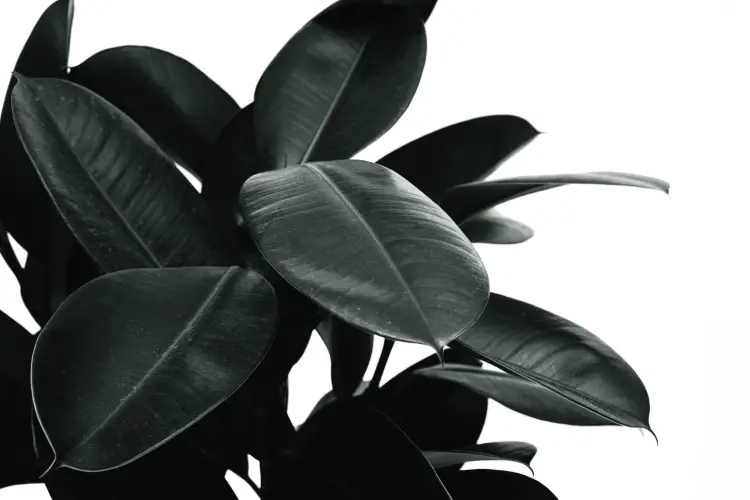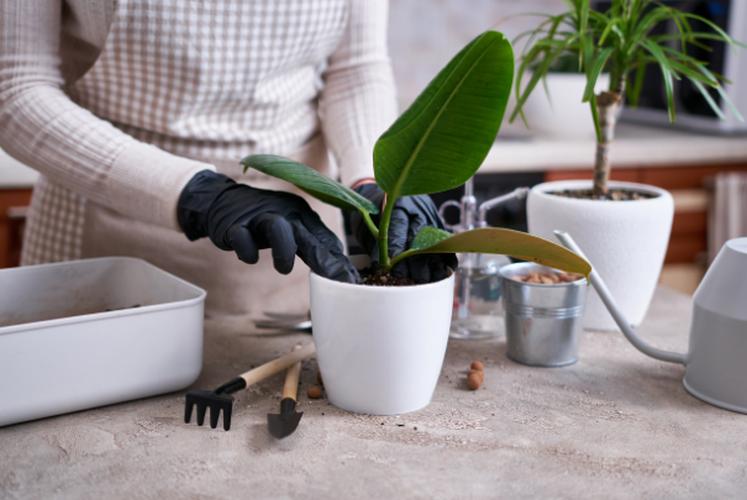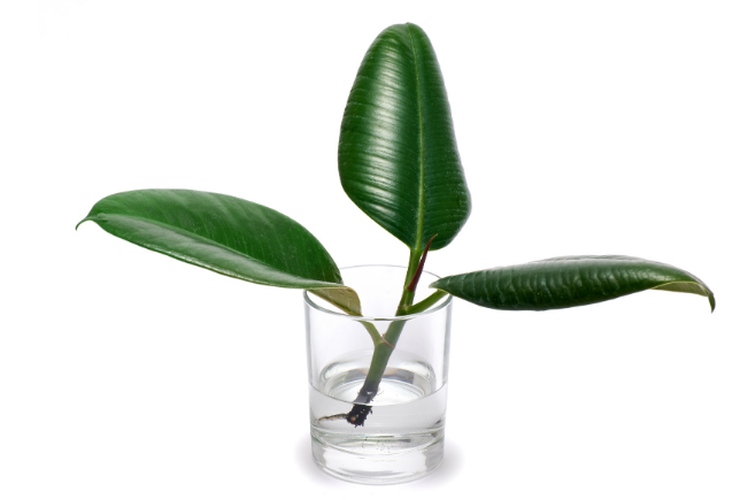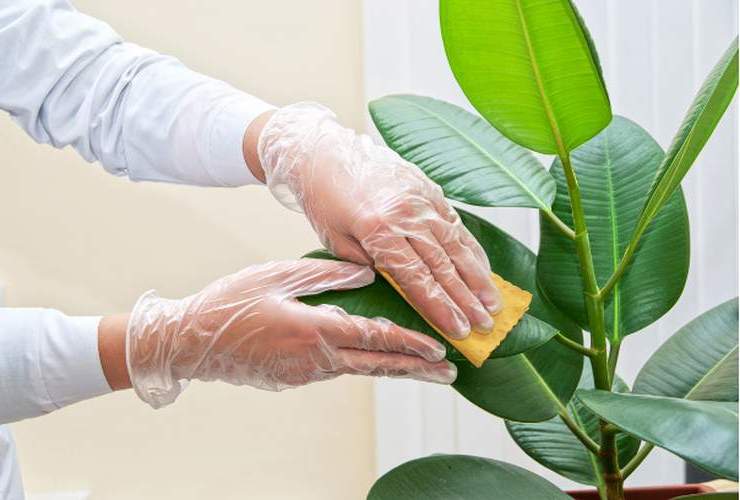
Rubber Plant care is not too complicated. In this article, you will find all about light, watering, temperature, soil, propagation, diseases, and other answers you may be interested in.
| Botanical Name (Latin Name/Scientific Name): | Ficus elastica |
| Common Name: | Rubber plant |
| Light: | full sun (5,000 lux – 40, 000+ lux) |
| Watering: | once the soil dries out to the bottom of the pot |
| Soil: | well-draining mix |
| Repotting: | once a year |
| Temperature: | 65°F to 85°F (18°C to 29°C) |
| Humidity: | 25% to 50% but it adapts well to any humidity |
| Toxicity for Pets: | Yes (vomiting, drooling, and mouth, tongue, and throat irritation) |
| Toxicity for Humans: | Yes (skin irritation, redness, itching, and rash to painful blisters like skin burns) |
| Propagation: |
|
| Pruning: | Prune dead or diseased growth or when you want the plant to branch out |
Light Requirements
| Minimal amount of light: | 5,000 lux (500 FC) |
| Optimal amount of light: | 40,000+ lux (4,000+ FC) |
| Direct sun tolerance: | 8 hours |
| Category: | full sun |
Rubber Plant enjoys full, direct sunlight all day long, but will do great in bright light as well (bright indirect light). It can survive even in lower light conditions but will soon lose a lot of its leaves, although it will live. If your Rubber plant wasn’t exposed to direct sunlight until now and now has the conditions to enjoy full, direct sun, adjust it gradually, so the leaves don’t burn.

Rubber Plant enjoys direct sunlight
If you don’t get enough natural bright light and your houseplant suffers from the lack of it, consider finding the perfect grow lights for your plants. Just type “Rubber Tree” or “Ficus” in the search box, and all the options will be listed.
If you want to buy grow lights and shower your Rubber Plant with light, but are not sure if and by how much they will increase your electricity bill, quickly calculate your monthly grow light cost and get your peace of mind.
Water Needs
The best rule of thumb is to treat your Rubber Tree like a succulent and water once the soil dries out to the bottom of the pot. I water mine approximately every 2 weeks, but I’ve gone even up to 3 months without watering, and the plant did great.
Rubber Trees should be watered once the soil gets completely dry. After you notice the soil got thoroughly dry, wait for a few more days, and water only then. If you’re not sure, you can always wait longer but it’s best to check. Use a chopstick to check the soil dryness. Stick the chopstick all the way down, and if it comes out fully dry with no soil attached, you’ll know that it’s time to water.
Remember, overwatering in combination with low light will cause leaf drop. On the other hand, once a Rubber Plant really needs water, the leaves will start to curl; make sure not to wait that long to water it.
Humidity Needs
Rubber Plant is a tropical plant and prefers humidity between 25% to 50% but it also adapts well to lower or higher humidity levels. Just make sure it enjoys enough light and don’t water it too frequently.
Temperature Requirements
Rubber plant loves warmth, so make sure to grow it in places with temperature between 65°F to 85°F (18°C to 29°C). The warmer the better though.
Fertilizing
If you repot indoor plants annually, you don’t need to fertilize them. Fresh soil will provide new nutrients, so generally, there won’t be any need to fertilize.
If you, for any reason, don’t manage to repot your Rubber plants annually with fresh soil, you can fertilize them as long as the plants are putting out new growth. The plants should be able to use nutrients for further growth, whether from fresh soil or from fertilizer. Use any 3:1:2 fertilizer such as the Sill fertilizer. This fertilizer has an excellent N-P-K ratio for foliage plants.
Soil
Well-draining soil is a great choice for Ficus Elastica. If you’re able to provide the plant with plenty of light, you can also use a tropical soil mix. These plants demand good drainage so the right soil mix is important for their health.
If you wish to make your own Rubber plant soil mix, you can use 3 parts any all-purpose potting soil, 1 part perlite, and 1 part bark. I get any peat-moss-based commercial potting mix and amend it with perlite and bark. This combination results in well-draining soil that will drain quickly and allow your Ficus Elastica to thrive.
Repotting
As for any other houseplant, I recommend repotting Ficus Elastica annually. Fresh soil will provide the houseplant with new nutrients, so generally, there usually won’t be a need to fertilize.
If the roots are coming out through the drainage holes or curl up at the soil surface, it’s time to repot.
When repotting your houseplant, go only up one pot size. For small pots (up to 4” diameter) one size will be an inch bigger. For larger pots (over 6”), the next size will be 2” bigger. If you go with too big of a pot, you risk that the soil stays wet for too long, especially if there isn’t enough light, which can lead to root rot.
For more detailed information on repotting, read the How to Repot a Houseplant (Properly) guide.

Rubber Plant care means also repotting it
Toxicity To Humans
Rubber Plant is toxic to humans if ingested and its sap or juice can cause a skin rash or irritation according to Ann King Filmer, Ph.D. Plant Scientist from the University of California, in the publication “Safe and Poisonous Garden Plants” from October 2012. Symptoms of dermatitis are: redness, itching, and rash to painful blisters like skin burns, according to California Poison Control System (CPCS).
Toxicity To Pets
Rubber Plant is toxic to pets, according to the American Society For The Prevention Of Cruelty To Animals (ASPCA). Usual toxicity symptoms are vomiting, drooling, and mouth, tongue, and throat irritation.
Pruning
I prefer my Rubber Plants to grow as single stalks, I just like that look. It’s probably because my mom has a 15-year-old Ficus that has a single stalk, so I spent a big part of my life looking at it and getting accustomed to that look.
If you prefer your Rubber plants bushier, just cut the tip and it will start branching out beneath the tip. If you cut a tip with a few leaves/nodes on it, you can propagate it in water or soil.
Remember, anywhere you prune your plant, new shoots will sprout. If you don’t have a lot of experience with indoor plants and pruning, an important thing to keep in mind is to leave at least one set of leaves on the main stalk, so the plant can photosynthesize, grow back more easily and you’re less likely to overwater it. If you’re more experienced, you are familiar with hard pruning, so in your case leaving leaves on the main stalk isn’t a requirement.
Propagation
A healthy Rubber plant is one of the easiest houseplants to propagate via tip/stem cuttings.
For a complete guide, follow the steps below:
- Cut the top off, just below a node. Node is a part from which a leaf grows. Remove the lower leaves. You can leave 2 to 3 leaves on the cutting. Even though it’s possible to propagate a cutting with more leaves, it can be more difficult as more leaves can use up more energy, and make it less likely for the cutting to successfully root.
- Once you have the cutting, you have 2 options:
- put it in water, next to the brightest window, and replace water once a week
or - put the cutting in soil, put the pot into a transparent plastic bag, seal it to keep the humidity high, and place next to the brightest window. Make sure to avoid direct sun, so the cutting doesn’t burn under plastic.
Whatever you choose to do, you will see the roots forming in a few weeks. If you selected the water propagation method, once the roots are about 1 to 2 inches long, you can put the cutting into soil.

A stem cutting in water
If your rubber plants have side branches, you can take cuttings from them as well. Make sure to use the green, young parts of the branches, that are actively growing.
The parent plant will branch out underneath the cut. Even if you don’t want to propagate your Rubber plants, by pruning them, you will make them bushier and lusher.
I prefer water propagation to soil propagation; I find it easier, with less hassle. You can see how I do it in the video below.
Pests
The Rubber plant is susceptible to scales, mealybugs, thrips, and fungus gnats. To get rid of the pests infecting your Ficus Elastica, you can use neem oil, horticultural oil, insecticidal soap, and systemic insecticide, in cases of severe infestation.
To treat your Rubber plant against scales, mealybugs and thrips, use horticultural oil, spray the plant thoroughly, both the topside and underside of all the leaves. To treat your Rubber plant against pests using 100% neem oil, mix it with water (1-2 tbs of neem oil per 1 gallon of water) and add a few drops of dish soap to emulsify the mix. Using a spray bottle, spray your Rubber plant thoroughly. After 4 to 7 days, repeat the process if needed.
If you’re treating your Rubber Plant with insecticidal soap, read the product label carefully, and spray both the top surfaces and undersides of the leaves. If needed, reapply the soap after 4-7 days.
In cases of severe infestations or on pests that are difficult to get rid of, such as thrips, use a systemic insecticide. Always follow the instructions on the packaging, to avoid damaging your plant. The general guideline is to use 1 tsp of insecticide per ¼ gallon of water and water the plant. The insecticide will be absorbed by the roots, and as pests feed on the plant they will ingest the insecticide.
Diseases
The most common diseases that affect Rubber plants are fungal Botrytis blight – (Botrytis cinerea) and Foliar Nematode (Aphelenchoides). Botrytis blight causes large, tan to brown leaf spots with concentric rings, and it is usually located between the leaf and sheath or on leaf tips. It’s best to prevent this disease since it’s difficult to treat. To prevent it avoid overhead watering, when buying plants choose healthy and sturdy plants, and space plants so that they get good air circulation.
Foliar Nematodes cause rectangular leaf spots that start along the midvein on lower leaves and extend to the margin. To prevent this disease, avoid overhead watering and keep your plants well-spaced.
Common Problems
Why are the leaves dropping?
There could be several reasons for the leaves dropping on your Ficus Elastica. Have you recently moved your plant to a different spot? This would be the most common reason for the leaves dropping. Rubber plants can drop several leaves in only a few days if you move them from one spot to a spot with less light. If you’ve found a good spot with bright light, try not to move the plant. Another reason would be overwatering. Only water your rubber tree once the soil has fully dried out, all the way to the bottom of the pot.
Overwatering
Like with any other indoor plant, overwatering is a common occurrence which can create a lot of issues with your Rubber plant. For example, overwatering can cause root rot or leaf drop. Overwatering is caused by a combination of lack of light/too frequent watering/watering with too much water/soil not being well-draining.
The sap should be avoided
A general recommendation is that small children and pets should keep away from Rubber plants as the sap can cause gastric irritation if ingested or irritate the skin. However, for the sap to come out, you would have to cut or break off a piece of the tree. If you make sure the houseplant stays in one piece, everyone should be fine.
FAQ
Are Rubber Tree plants fast growers?
Rubber trees can grow around 24 inches per year, under good conditions. To do that they need plenty of light and direct sun. When they get more light, they will grow faster, grow larger leaves and be healthier. Remember, light is plant food!
How to Clean Rubber Plant Leaves?
Clean the leaves of your Ficus Elastica with a damp cloth as soon as you notice accumulated dust, so the houseplant can breathe and photosynthesize easily. It’s best to wipe the leaves of your Rubber tree plant regularly, at least every week or every couple of weeks, using a soft damp cloth.
Do not use leaf shining products as they can clog stomata, which the plant uses to breathe.

Gently clean the Rubber plant with a damp cloth
Is A Rubber Plant Hard To Care For?
A Rubber Plant is easy to care for. Make sure to provide the plant with sufficient light and direct sun, and proper watering, and you will have a healthy and beautiful plant.
How Do I Know If My Rubber Plant Is Healthy?
Your Rubber Plant is healthy if the leaves are green or burgundy, without specks and brown patches and they are not falling.
How Big Do Rubber Plants Get?
Rubber Plants get 6-10 feet tall when growing as houseplants. In their natural habitat, they can grow up to 100 feet tall.
Enjoy your Rubber tree plant!
I love all varieties of Rubber plants — green, burgundy, variegated… you name it!
Do you have a favorite? What are your experiences with Rubber plant care?
I hope you found all of the information in this Rubber plant care guide helpful and that if you had any doubts until now, you don’t have them anymore. If you have any additional questions or a particular problem with your Rubber plant care routine, don’t hesitate to schedule a private consultation session with me. I’m always happy to hear from you!
Yours Truly,


Related Posts
Sansevieria Black Gold (Snake Plant Care GUIDE!)
Spathiphyllum Sensation (FULLY Explained!)
Alocasia Stingray Care